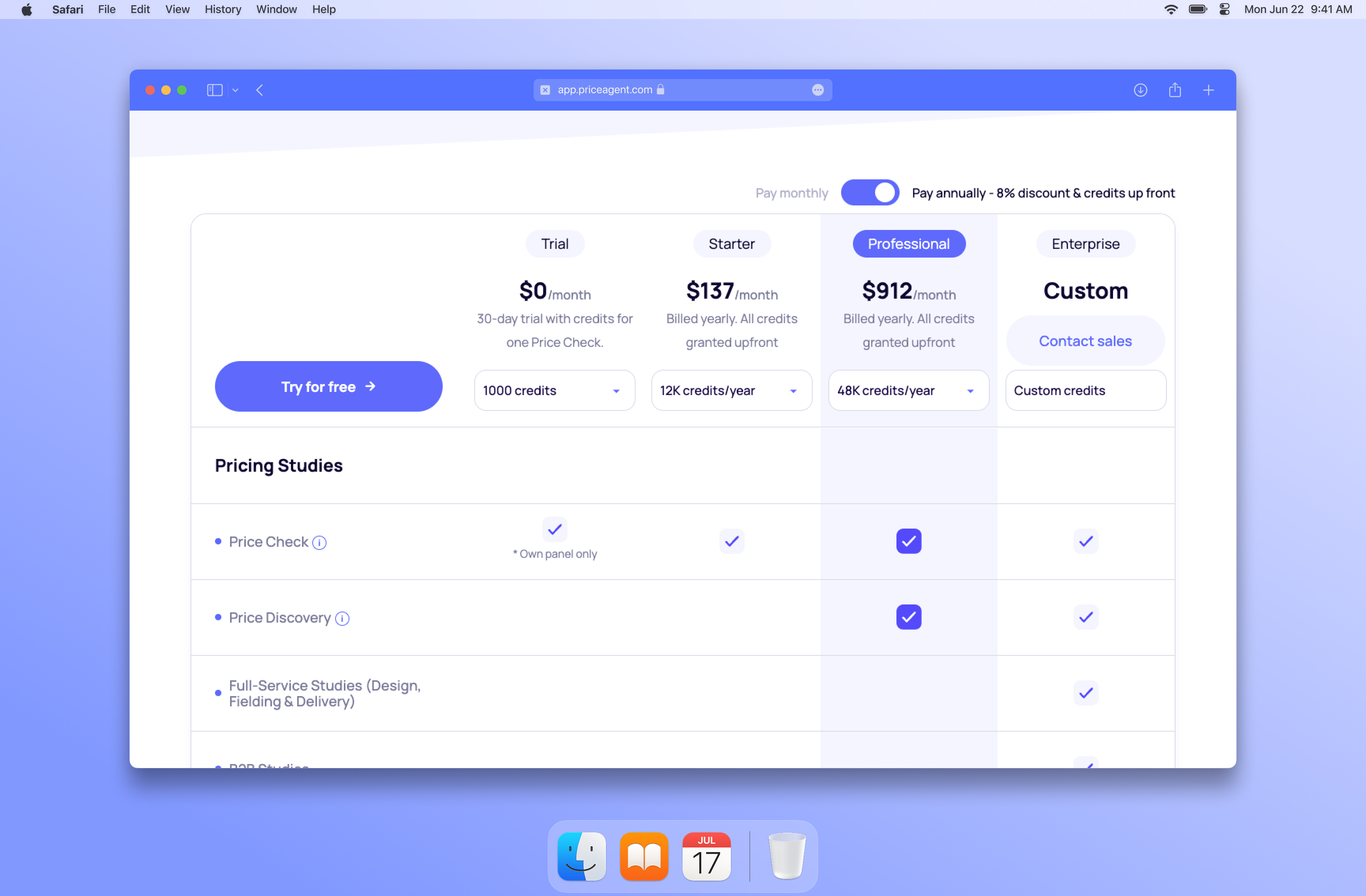The common pricing challenges for startups and scaleups
Why pricing isn’t a one-time choice but a system that shapes growth.

Summarize article with AI
Pricing is not a one-time decision. It is a system that shapes product, sales, margins, and brand. Early choices compound. Later choices must adapt. For startups, three challenges dominate again and again: choosing a model that aligns cleanly to customer value, balancing growth against profitability with intent, and building the discipline to adjust prices at scale without breaking trust. Companies that anchor pricing in measured demand, not imitation or habit, build resilience. Pricing becomes less about guesswork and more about steering growth with confidence.
Choose a model that maps to value, keep it simple at the start
One of the first pricing hurdles for a young company is deciding not only how much to charge, but how the model itself should work. This choice influences customer adoption, perceived fairness, and future revenue growth. Unlike a specific price point, which can be adjusted, the model is harder to change later, since it touches billing systems, sales compensation, and customer expectations.
The most successful cases show that simplicity and alignment with value are what matter most. Slack built early momentum with “Fair Billing,” where companies paid only for active users and automatically received credits for inactive seats. This created trust and made it obvious that pricing scaled with the value customers received. Twilio did something similar in a different domain by charging pay as you go on usage from day one, which lowered barriers to entry while ensuring that revenue grew with adoption. Larger companies have had to adjust later when they missed this alignment. Autodesk introduced its Flex token system to complement subscriptions, allowing customers to test products without long commitments.
Founders should look for signals that point toward the right model rather than relying on guesswork. Talk to early customers about how they expect to pay, and watch how usage patterns develop. Run simple comparisons between per-seat, usage-based, or transaction-based pricing to see which one grows most naturally with adoption. Pay attention to which features or channels drive real engagement, and anchor your pricing to those moments of value.
Many startups fall into the same traps. Free tiers that give away too much value may attract large numbers of users who never convert, leaving the business stuck with weak monetization. On the other end, complex bundles can confuse buyers and bury the product’s real value proposition under layers of pricing mechanics.
The companies that get this stage right pick a model that is transparent, easy to explain, and clearly tied to customer benefit. By testing and observing early, founders can spot what scales with adoption and set up a structure that drives both trust and long-term growth.
Use price as the growth versus profitability dial
Once the model is in place, the next question is how hard to lean on price for adoption versus margins. Since 2022, most startups operate in a very different capital market, and investors reward efficient growth rather than growth at any cost. YC has pushed teams to be “default alive,” and venture monitors show slower funding and exits through 2024. Strategy work from HBR and McKinsey highlights the shift to efficient growth metrics like the Rule of 40. In practice, pricing is still a dial, but the tolerance for broad, long running subsidies is lower.
Pricing works like a scale, shifting between adoption and yield as conditions change. Companies constantly rebalance rather than follow a fixed sequence.

There are still targeted cases for early underpricing. In network effect markets you sometimes need to buy liquidity first, then turn to margin. Uber’s January 2016 price cuts across 100 plus cities, mirrored by Lyft, are the classic seasonal demand stimulus. OpenSea kept a low 2.5 percent marketplace fee to reduce friction in a nascent NFT category. Use this play where liquidity is the constraint and only for as long as it is needed, then test back toward contribution positive economics.
On the other side of the spectrum, established brands often turn the dial toward profitability even if it means slower growth. Procter & Gamble raised prices across staples like Tide and Gillette and accepted mid single digit volume declines to protect margins in an inflationary environment. Spotify followed a similar pattern over time. For nearly a decade it kept its Premium plan near $9.99 to scale globally, then began raising prices region by region once adoption and value were proven, including the 2023 U.S. increase and broader 2025 moves in multiple markets. Tesla made the trade off explicit in 2023, prioritizing higher volumes and a larger fleet over automotive gross margin.
The challenge for any startup is knowing when to move from land grab to harvest. The best founders watch how pricing decisions actually play out. Do discounts add real volume, or just give away revenue? Do higher prices stick, or do they trigger customer churn? Where does adoption flatten, showing you may have reached a ceiling? And which customer groups or channels respond differently, giving you room to adjust without hurting the whole business? With this insight, leaders can shift between growth and profitability with intent instead of relying on gut feel.
The risk of ignoring these patterns is getting stuck in the middle. Stay too cheap for too long, and you weaken profitability and lose investor confidence. Raise prices too soon, and you stall adoption and erode trust. The companies that manage this best treat pricing as a living lever. They adjust deliberately, shifting between growth and profitability based on what they see in customer behavior, not on competitor moves or short-term pressure.
Build a pricing system for scale
Once a company has found product market fit and an initial pricing model, the real work begins, building the discipline to refine, adjust, and expand pricing as the business scales. What worked for the first hundred customers rarely works for the first thousand. Markets evolve, new segments appear, and costs shift. Treating pricing as a living system, not a one time setup, separates companies that plateau from those that keep growing.
SaaS data shows that nearly all successful scaleups revisit their pricing regularly. In 2023, over 94 percent of B2B SaaS pricing leaders updated pricing or packaging at least once per year, and almost 40 percent did so quarterly. The principle applies beyond software. Consumer brands frequently adjust retail prices in response to costs and demand. Marketplaces evolve take rates as their value proposition deepens. Companies that institutionalize iteration see pricing not as a risk, but as a lever for ongoing optimization.

The shape of that optimization often involves expanding structure. GitHub layered usage based overages onto its per user plans, monetizing heavy users without alienating smaller teams. Autodesk added Flex tokens alongside subscriptions to attract casual users. Netflix added plan types such as an ad supported tier and has repeatedly paired price increases with clear value framing in shareholder communications. These examples show how scale almost always brings diversification in tiers, packages, or monetization streams.
At the same time, scaling requires cleaning up the past. Many startups hand out sweetheart deals, deep discounts, or unlimited packages to win early customers. Left untouched, these legacy contracts become revenue leaks. Mature companies eventually sunset them, normalizing users onto current tiers with careful communication and grace periods, often by grandfathering existing customers while moving new customers to the updated structure. This is not just about fairness. It is about ensuring that every customer pays in line with the value they receive.
At scale, pricing should never become a black box owned by a small group. The companies that succeed make testing continuous and accessible. Every change; a new tier, a discount, an add-on, is treated as an experiment that can be measured, not a one-off decision. Just as website traffic is visible in Google Analytics, pricing performance should be available to everyone who makes growth decisions, from product to sales. The goal is not to centralize pricing into a specialist team, but to embed it across the organization so that evidence guides choices at every level.
Companies that build this kind of system gain two big advantages. First, they grow revenue from the customers they already have by making sure pricing keeps pace with the value delivered, without triggering unnecessary churn. Second, they stay flexible. When markets shift or competitors move, they can test, learn, and adjust quickly instead of being stuck with pricing that no longer fits.
Execute price changes with evidence and customer trust
Even with the right model and system in place, the hardest step is execution. Whether it’s raising prices, introducing new tiers, retiring discounts, or lowering entry points to drive adoption, the risk is the same: churn, backlash, or lost trust. Many founders hesitate here, which quietly erodes margins and slows growth. The challenge is not whether to adjust, but how to do it in a way customers accept.
The companies that succeed follow a clear playbook. They frame changes around added value, and when possible, provide alternatives at different price points. They grandfather loyal customers on legacy plans while moving new ones to updated tiers. They use discounts or promotions in controlled bursts, testing if they add real volume or simply give away revenue. And they roll out changes in phases, starting with a single market or segment to see the reaction before scaling.
Handled with transparency, pricing changes can even strengthen customer relationships. They show that the company is aligning price with delivered value, not just extracting more revenue. The difference lies in execution. Companies that communicate clearly, phase intelligently, and use evidence to guide adjustments prove that pricing can be both sustainable and trusted.
Conclusion
Pricing is one of the few levers that directly shapes both growth and profitability. The companies that master it don’t treat pricing as a one-time decision, but as a system that adapts as markets and customers evolve. The pattern is clear: start with a simple model that aligns to value, use price as a deliberate dial between adoption and margin, build the discipline to iterate at scale, and execute changes with evidence and trust.
What separates the leaders is not luck, but discipline. They test instead of guessing. They look for the points where adoption slows or customers react, and adjust with intention. They communicate changes clearly so customers see the value behind them.
Companies that build pricing on evidence outperform those that rely on habit or imitation. By anchoring early decisions in customer value, shifting deliberately between growth and profit, and treating pricing as a living strategy, startups and scaleups can avoid common traps and unlock durable growth.









